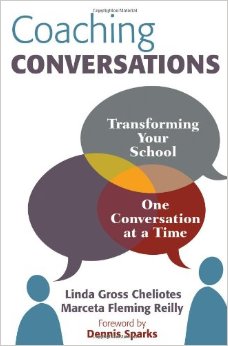I’ve recently started a book club around my text on digital portfolios for students. We are currently discussing Chapter 1 in a Google+ Community, using a thought-provoking question or statement for the participants to respond to asynchronously per day.
As we discuss in this online space, I have come back to a text I’ve used in the past regarding coaching:
This text was referenced in a connected coaching course I took with Lani Ritter Hall a few years back. It is a very practical resource for school leaders and coaches. At less than 100 pages, I can quickly go back and find the most salient points to reference in my work with connected educators in online spaces. Here are a few of my favorite parts of the text.
Coaching conversations differ from typical, spur-of-the-moment conversations. First, they are highly intentional rather than just friendly or informal interactions. In addition, coaching conversations are focused on the other person – her strengths and her challenges, and the attributes she brings to the conversations. A third characteristic of coaching conversations is that their purpose is to stimulate growth and change. In other words, coaching conversations lead to action. (p 3)
This is a lengthy quote. Let me break it down into the three main attributes of coaching conversations:
- Highly intentional
- Focused on the other person
- Purpose is to stimulate growth and change
With each response to someone’s post in our Google+ Community, I try to apply these characteristics. My comments are considerate of where the person is at in using digital tools for student assessment, and where they want to go. This awareness helps me remain focused on the person and their situation, for example by noting specific details they shared in their initial post. My overall purpose, to stimulate growth and change, can be realized by keeping my comments objective and my questions open-ended (“You stated that you want to focus on building a better audience for your students. What activities and tools might allow for you to make this happen in your classroom?”)
When you are a committed listener you focus your full attention – mind and body – on what the other person is saying. You listen not only to the words expressed but also to underlying emotions and body language. In other words you listen to the essence of the conversation. (p 30)
This is where having coaching conversations in online spaces becomes a challenge, for the obvious reasons. We cannot read body language or assume underlying emotions. It is more difficult to express ourselves in this way within this medium. What I try to do is use positive presuppositions (52). This means assuming that the other person has the best of intentions, and to respond in a manner that allows for the person to expand on their ideas. This “pulling out of their thinking” again involves making observations and asking wondering questions.
One of the benefits of learning in online spaces is the spaces of silence that naturally occur, especially in asynchronous situations where time is not a factor in posts and responses.
Committed listeners…recognize the value of silence in conversations and avoid unproductive listening patterns that interfere with the deep listening of coaching conversations. (p 30)
One of our teachers pointed out the benefits of silence during a prior online learning community. “When you are not expected to answer a question right away, it gives you time to thinking and reflect on possible responses.” This period of reflection can allow learners to develop smarter responses, an advantage of learning online vs. in person.
I became very intentional about trying to separate my coaching from my mentoring. I tried to be transparent when I was mentoring, ask permission before I did it, and most importantly, to be intentional about not doing it. (p 92)
There is a fine line between coaching and mentoring. “In coaching conversations, instead of giving advice, the school leader supports her staff by paraphrasing what is said and asking powerful, open-ended questions that lead to deeper thinking” (57). Mentoring is different. A mentor gives direct advice, in fact telling the person on the other end of the conversation what he or she might want to try in their practice.
I am sure there a few members in our Google+ Community that would like to be told what to do. However, it is more important that they arrive at a deeper understanding for student-centered assessment on their own terms when possible. Of course I will offer advice when asked. But I believe the best learning happens when we can build a deeper understanding together, with the learner doing the lion’s share of the work.
This short animation, also shared during the Connected Coaching course with Lani Ritter Hall, nicely sums up this concept for me of coaching and learning in online spaces.


